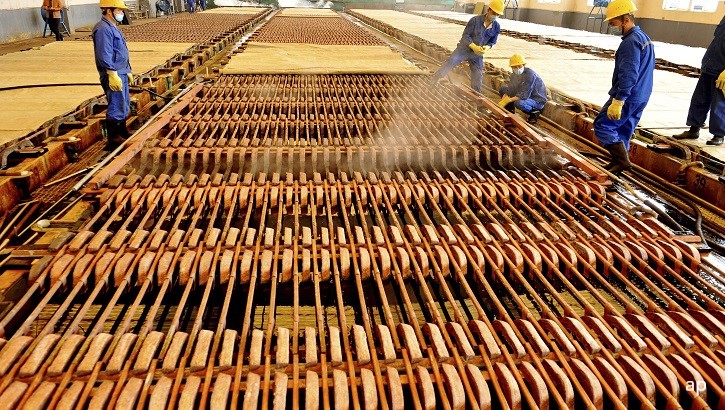
They call it the red metal and it has commonly been used as a health indicator for the global economy. But beyond its many uses, a new horizon is opening up for copper; that of the energy transition.
Global efforts to decarbonise are in fact acting as structural growth engines for many commodities or metals. In this context, copper can be seen as a key metal for the green shift and, together with nickel, is needed to transform energy and transport sectors.
“The demand outlook is promising,” says Manuel Zeuch, commodity analyst at DJE Kapital AG.
“Annual installations of renewable energy generation capacity could more than quadruple by 2030 and the number of electric vehicles sold per year could increase 18-fold by 2030, compared to 2020. The expansion of renewable energy generation capacity is accompanied by the need to expand electricity transmission networks.”
Copper is an excellent conductor of electricity, making it the ideal material for renewable energy systems. Its high electrical conductivity enables efficient energy transfer, minimising power losses during transmission and distribution.
The main use of refined copper (74%) is wire rod. About 63% of these are used for electric cables, 21% for solenoids, 15% telecommunication cables and 3% special cables. Current forecasts by market research institutes like CRU, Wood Mackenzie and International Copper Association, assume that by 2030, out of a projected total demand of more than 30 million tonnes (from 24 million in 2022), around 7 million will come from the energy transformation sectors (renewable energy, electric vehicles, grid expansion).
“However, this additional demand cannot be met by increased mining production, so a market deficit of around four million tons is expected by 2030 from today’s perspective,” Zeuch explains.
The supply of copper is in fact rather fragmented globally. The mining supply is about 22 million tonnes. The residual part comes from the recycling of scrap and waste, which will be increasingly important in the future. New copper mining projects, moreover, cannot be started up so quickly: major mining companies such as Anglo American (AAL) or Glencore (GLEN) point out that the complete development of new mines – from discovery to production – currently takes about 15-20 years.
Without Copper, no Wind and Solar
Today, wind and solar power are among the most popular forms of renewable energy. The chart below shows the amount of copper required to generate energy from offshore wind, onshore wind and solar photovoltaics compared to fossil fuels such as coal and natural gas.
Copper is widely used in wind turbines and is also a key element in solar panels. Plus, for the renewable energy generated to be used effectively, we need effective grid infrastructure and energy storage, which again, is reliant on copper, as Mobeen Tahir, head of macroeconomic research at WisdomTree, explains.
“In energy storage systems, which assist renewables by conserving energy for the days when the wind doesn’t blow or the sun doesn’t shine, copper is used inside batteries and super capacitors.”
According to Tahir, copper is an irreplaceable raw material for renewable energy, and as the large-scale energy transition progresses, its use will only continue to grow.
Demand from China and the US will Support the Price
The investment case on copper as a secular trend is also supported by Alexander Roll, associate investment strategist at Global X, who argues that the stricter standards for car exhaust pollution introduced in the US, as well as the Inflation Reduction Act, will drive massive investment in electric charging infrastructure and battery production.
But it is not just the US. “China’s building and construction sector is a major driver of copper demand, responsible for 30% of global demand,” Roll says, adding that major government packages aimed at real estate developers is fuelling the construction recovery in the country. What’s more, the real estate sector has received $162 billion in financing from major banks, injecting significant liquidity into Chinese real estate.
Finally, problems in mining regions such as Chile and Peru, which account for almost 40% of the world’s copper supply, have caused delays in the delivery of raw copper, leading to production disruptions.
“These challenges are compounded by low copper stocks in the US and Europe, which raise concerns that the market may soon be in a deficit condition. The depletion of reserves increases the risk of a price spike, as traders may rush to replenish their stocks,” the Global X analyst concludes.
Copper in the Portfolio
The easiest way to gain exposure to the spot price evolution of a commodity is through ETCs (exchange traded commodities). European investors can choose from seven ETCs focused exclusively on copper, as well as several other instruments offering exposure to a diversified basket of industrial metals. The list below excludes short instruments (which offer an inverse result with respect to the benchmark) or leveraged instruments (which amplify the results – often on a daily basis – of the replicated index).
As can be seen from the returns shown in the table, these instruments are not equivalent. They often replicate different benchmarks, based on different methodologies, which results in a divergent risk-return ratio.
For example, the benchmarks of the RICI Enhanced family (created by Jim Rogers in the late 1990s) depart from the common practice of using the futures contract with the closest expiration date as the price source; this is to try to minimise the contango effect. A very important element in determining the value of synthetic ETCs is in fact related to the rolling effect, which is simply the replacement of the expiring futures contract. Rolling is negative if the expiring contract has a lower price than the new one (so-called contango) and is positive in the opposite case (backwardation).
Therefore, the RICI Enhanced benchmarks invest in futures contracts with different maturities to smooth out the price differentials of the various futures contracts. For each individual commodity, a particular schedule is defined for the replacement of the benchmark futures contracts, which also takes seasonal cycles into account; finally, a liquidity filter eliminates under-traded futures contracts. This explains the generally higher fees charged by these strategies.
For those who instead of having direct exposure to the commodity itself prefer to focus on companies that mine and trade copper, two ETFs are available in Europe: the Global X Copper Miners UCITS ETF (COPX) and the new iShares Copper Miners UCITS ETF (COPM), launched by BlackRock a month ago, on Euronext Amsterdam. The former replicates the Solactive Global Copper Miners v2 TR index, while the latter tracks the STOXX Global Copper Miners Index.
These two funds hold many overlapping stocks, as one might expect, but with different weights. The two biggest names within the Global X portfolio, for example, are Lundin Mining Corp (LUN) and Ivanhoe Mines (IVN), while in the case of the iShares ETF, the two spots at the top of the portfolio are occupied by Freeport-McMoran (FCX) and First Quantum Minerals (FM).







:quality(80)/cloudfront-us-east-1.images.arcpublishing.com/morningstar/6BCTH5O2DVGYHBA4UDPCFNXA7M.png)




















